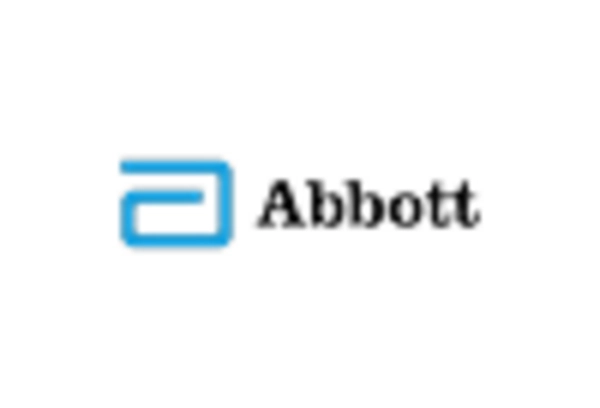The bioelectronic sensors market is currently characterized by a dynamic competitive landscape, driven by technological advancements and increasing demand for innovative healthcare solutions. Key players such as Medtronic (US), Abbott Laboratories (US), and Boston Scientific (US) are at the forefront, each adopting distinct strategies to enhance their market positioning. Medtronic (US) focuses on innovation through substantial investments in research and development, aiming to expand its product portfolio in neurostimulation and cardiac monitoring. Meanwhile, Abbott Laboratories (US) emphasizes strategic partnerships and collaborations to enhance its sensor technologies, particularly in diabetes management. Boston Scientific (US) is actively pursuing mergers and acquisitions to bolster its capabilities in bioelectronic devices, thereby enhancing its competitive edge in the market.
The business tactics employed by these companies reflect a trend towards localizing manufacturing and optimizing supply chains to improve efficiency and responsiveness. The market structure appears moderately fragmented, with several players vying for market share, yet the collective influence of major companies is significant. This competitive environment fosters innovation and drives advancements in bioelectronic sensor technologies, as companies strive to differentiate themselves through unique offerings and enhanced functionalities.
In October 2025, Medtronic (US) announced the launch of its next-generation implantable cardiac monitor, which integrates advanced bioelectronic sensing capabilities. This strategic move is likely to enhance patient monitoring and improve clinical outcomes, positioning Medtronic as a leader in cardiac care. The introduction of this technology underscores the company's commitment to innovation and its focus on addressing unmet medical needs in the cardiovascular space.
In September 2025, Abbott Laboratories (US) expanded its partnership with a leading technology firm to develop a new generation of continuous glucose monitoring systems. This collaboration is expected to leverage cutting-edge sensor technology and artificial intelligence, potentially revolutionizing diabetes management. By aligning with tech innovators, Abbott aims to enhance its product offerings and maintain a competitive advantage in the rapidly evolving healthcare landscape.
In August 2025, Boston Scientific (US) completed the acquisition of a bioelectronic device startup specializing in neuromodulation technologies. This acquisition is anticipated to significantly enhance Boston Scientific's capabilities in the bioelectronic space, allowing for the development of more sophisticated therapeutic solutions. The strategic importance of this move lies in the company's ability to integrate new technologies and expand its market reach, thereby solidifying its position in the competitive landscape.
As of November 2025, current trends in the bioelectronic sensors market indicate a strong emphasis on digitalization, sustainability, and the integration of artificial intelligence. Strategic alliances are increasingly shaping the competitive landscape, enabling companies to pool resources and expertise to drive innovation. Looking ahead, competitive differentiation is likely to evolve, with a shift from price-based competition towards a focus on technological advancements, innovation, and supply chain reliability. This transition suggests that companies will need to prioritize research and development, as well as strategic partnerships, to remain competitive in an increasingly complex market.
















Leave a Comment